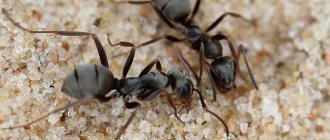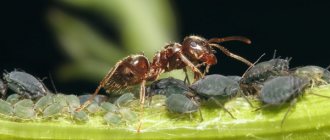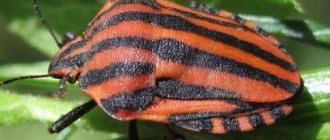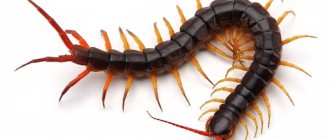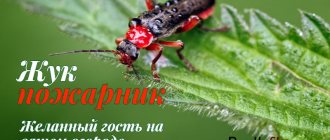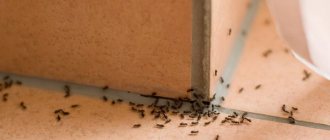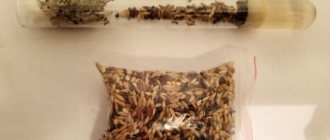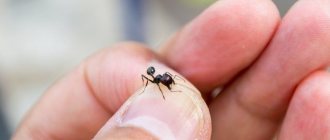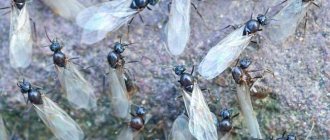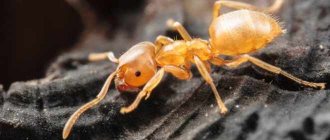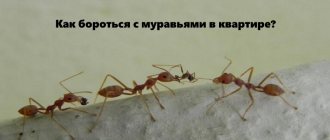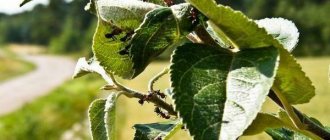It is quite difficult to notice a small anthill in the garden. These are not huge heaps, rising almost 50-70 cm above the ground, and the garden species themselves are much smaller than their forest “compatriots”. But it will soon become clear that in your garden, in your vegetable garden, someone besides you is in full charge. This does not scare many gardeners, because finding a summer house or garden without anthills is quite difficult. And if there are no busy insects on the site or in the neighbors, this should rather alert you - ants avoid places with high groundwater levels and contaminated soil.
Anthills are unique natural “indicators” of the soil. If there is a “house” of insects on the site, you can rest assured that the soil is not contaminated, the underground water table lies at a sufficient depth, and the crops and foundation will not float in the water.
Garden ants, types and characteristics
Every person was taught from childhood that they should never destroy anthills. Many examples were given of their benefits, extraordinary hard work and endurance.
Over time, opinions about ants began to change.
Walking through the garden, you suddenly notice that your favorite roses stop opening. In the flower you see crawling ants and gnawed unopened buds. And it is not clear who gnawed them - the ants themselves or the individuals they carried - aphids .
There are several varieties of ants. One of them is black garden . This insect is small, 3-5 mm in length. Black color. It settles in rotten trees and soil, creating a mound.
Black garden ants
Red ants are also found in gardens, but much less frequently.
An ant family consists of one queen, several males and a huge number of so-called workers . The queen and males emerge from the pupae and have wings. Workers do not have wings. After fertilization of the uterus, the males die. The queen sheds her wings, finds a new nest, lays eggs there, forming a new family. The lifespan of the queen of this species is 28 years.
This type of ant settles in areas, creating a lot of trouble for the owners.
The number of individuals increases several times over a short period of time. The number of anthills is growing at a high rate; the increase in such mounds is 1-3 per week.
What are they doing in the garden? Is it worth fighting them or leaving everything as it is?
Locations
Insects often create anthills in places suitable for life and breeding (warm, near water and food). Therefore, ants are rarely found in living rooms. They usually live in the kitchen and bathroom. The colony can be found behind the sink, behind cabinets, on the floor between boards, under the bathtub. In the bathroom, the nest is usually located in damp areas behind cabinets or behind tiles. Ants can also live in the basement. Humidity, warmth and food nearby are the best conditions for organizing their colony.
Note!
Often the reason for the appearance of ants is a constantly uncleaned kitchen with food leftovers.
In apartments, ants create a colony, which includes a queen, drones and workers. Their nest can be found in unexpected places - the area behind the baseboard, a flower pot, the cracks behind the tiles.
The benefits of ants for the garden
- They feed on harmful insects and caterpillars . In a day, residents of just one small anthill can eat tens of times more harmful insects than a bird.
- Moving among the flowers, they pollinate them.
- They loosen the soil quite actively . Penetrating 0.5 meters deep, they mix the soil well with all kinds of blades of grass, leaves and other woody and herbaceous structures. Insect remains also act as soil fertilizers. The soil is saturated with useful minerals and organic matter.
- By loosening the soil, ants saturate it with oxygen . It has been noticed that plants grow much better when located near an ant heap. The soil becomes more fertile. If earthworms are able to penetrate no more than 20 cm , then ants can build an entire city underground at a depth of 1.5 meters . Nutrients and water penetrate there. The roots of the plants feel great at the same time.
- A medium-sized anthill will save the garden from 2 thousand individuals of harmful insects and larvae in 1 day .
- Ants provide food for birds and some animals. And not just food! A bird enters an anthill, the ants, crawling under the feathers, rid it of parasites, and formic acid can even treat birds from diseases.
- The presence of ants improves the composition of the soil - the potassium content doubles and the phosphorus content increases 10 times. Thanks to the soluble form, potassium and phosphorus become more absorbable by plants.
But in search of food, an army of ants spreads throughout the entire area, causing significant harm.
How to keep garden ants out of trees
The goal is not to completely destroy the anthill; you just need to block the ants’ path to the trees, while creating various barriers for them. If the foundation of your garden is not beautiful landscaping, then this method can be very effective.
To protect and block the path to your plants, we recommend using one of the listed methods to get rid of garden ants once and for all.
Water hazard made from a car tire
Ways to remove ants:
- Water barriers (like a moat around a castle). They provide invaluable benefits. This method can be recommended if ants are causing harm, and it is necessary to prevent them from approaching ornamental plants, berry bushes, or where there are many trunks and they are thin. To do this, you need to take a tire, cut it in half along the tread, thread a bush through it and bury it under the ground so that the edges of the tire are visible. After making sure that everything is done correctly, you can freely fill the tire with water and admire your creation and be calm about the plants.
- Foil skirt. The foil must be wrapped around the trunk and secured, you should get a skirt with sharp edges. The ant is not flexible enough to climb over such an obstacle.
- Belt with glue (belt-trap). As in the previous case, it needs to be wrapped around the trunk of the plant and secured with ropes. At the same time, harmless insects do not climb onto the belt. It is advisable to attach the belt at a distance of approximately 50 to 90 cm from ground level in early September before the onset of cold weather.
Glue trap
Damage caused by ant families
- In places where ants live soil acidity increases and plants develop poorly.
- They gnaw at sweet fruits and berries—strawberries and wild strawberries are the first to suffer.
- They eat the sweet petals of flower buds, which spoils them and prevents them from blooming to their full potential.
- They spread weed seeds.
- In addition to aphids, ants breed some types of caterpillars, cicadas and other pests.
- They gnaw out the sown seeds.
- They gnaw the roots of plants.
- They breed aphids.
This is perhaps the most harmful influence of the ant family.
Aphids are the most consumed food for ants. For the winter they bring it into their nests. With the onset of spring, he plants it on leaves and literally grows it for himself.
Aphids in the garden plot pose a great danger. It's hard to fight her. It is capable of destroying literally everything in the garden. Ants are so sensitive to these insects because they feed on the juice secreted by aphids.
Destruction of garden ants by destroying their home
From the name of the method you can already guess that the ants will not live after this, and such a problem as harm from these insects will be avoided. An ant without its own home is not an ant, and therefore the following options are proposed for destruction:
- you can pour boiling water into the anthill;
- kerosene in the anthill;
- An effective method, after which not a single ant remains, is to fill the anthill with hot ash;
- pour the poisonous solution.
Ants cannot stand the smell of herring - once they place the fish on an anthill, they will soon leave their home
Enemy classification
Despite the fact that insects bring great benefits in nature, their populations cause considerable harm to the crop, as well as to humans themselves. They clean the forest, loosen the soil, pollinate plants and process waste.
The ant itself is an invaluable source of carbohydrates and proteins, so for many animals this species is a real delicacy. In nature, there are many representatives of the animal world who prefer to feed on these tiny insects.
Enemies of ants are conventionally divided into 2 types:
- Internal. They enter the body of insects in various ways or are able to live with them in the same territory.
- External. These include representatives of the fauna that use ants as food.
Why are ants useful?
Ants provide aeration and soil movement in tropical and temperate forests. Many species of these insects loosen, mix and fertilize the soil. In areas with hot and dry climates, they increase yields.
Many species of ants are an important link in the food chain - they serve as food for many animals. In addition, individuals settling in dead wood participate in its mechanical destruction, thereby accelerating decomposition.
It is thanks to ants feeding on plant seeds that many species of flora successfully spread. For example, violet, hoofweed and woodland spread exclusively thanks to ants. These are the only insects capable of dispersing plant seeds in huge quantities, in all ecosystems and on all continents.
Ants are also record holders for capturing carbon dioxide from the atmosphere. Thanks to these insects, chalk, marble and limestone are converted into magnesium and calcium carbonate 50-300 times faster.
In South Africa, ants are used to harvest rooibos bushes (herbal tea). The fact is that during the fruitful period, rooibos scatters its seeds quite far. And black ants collect them and store them in a nest, from where people take them. One anthill contains up to 200 grams of seeds.
Medicinal ant bites
Ant bites can cause unpleasant consequences in some cases. But despite this, in medicine they are considered healing. It's all about formic acid. It contains zinc complex - an excellent antioxidant and immunostimulant. Among other things, formic acid protects the body from chronic diseases, atherosclerosis and the negative effects of free radicals.
Treatment procedure: you need to find an anthill in the forest, undress to your underwear, plug your ears with cotton wool, lower a prepared birch broom into the anthill and let the ants climb onto it, and then transfer the insects to yourself. The procedure is usually carried out for five minutes, after which all ants must be carefully shaken off. Complete the procedure with a warm shower.
Treatment
The healing properties of ants have been known for a long time. From time immemorial, people have made tinctures and ointments from them. These insects are still used today. The main active ingredient in such preparations is formic acid.
Acid-based drugs help in the treatment of arthritis, rheumatic and atrophic, neuroses, dizziness in old age. They can also alleviate the condition of patients with hepatitis.
Preparations with a hemostatic effect are prepared from ants. Their venom also contains antibiotics that can fight fungal and bacterial infections, including staphylococci and streptococci.
Before you destroy these little workers on your plots, evaluate the benefits they bring.
Description
Ants are from 7 to 14 mm long, red-brown in color (the chest, stalk and cheeks are reddish-red, the abdomen and part of the head are black). The antennae of workers and females are 12-segmented with a long first segment (scape); in males they consist of 13 segments. The anterior edge of the clypeus is without notch, rounded. The frontal area of females and workers is shiny. The occipital margin of the head is convex, containing only adjacent hairs (in Formica aquilonia
back of the head with erect hairs).
On the bottom of the head there are several pairs of spaced hairs (in the closely related species Formica polyctena
they are absent or only adjacent).
On the top of each chest segment there are more than 3 pairs of spaced hairs (in F. polyctena
there are less than 3 pairs).
The scutum and abdomen of females are shiny (in the closely related species F. polyctena
they are matte). Half of the abdomen is occupied by an acidic poisonous gland, surrounded by a powerful muscular sac. When muscles contract, the poison is released over a distance of several tens of centimeters. The stalk between the breast and abdomen consists of one segment (petiolus), bearing a vertical scale. Huge anthills more than one and a half meters high contain hundreds of thousands of ants (up to a million or more). The nests are built from twigs, needles and other plant and soil material. In addition to hunting insects, large colonies of ants collect 450-500 kg of aphid honeydew per season.
Myrmecophiles
Ant nests harbor hundreds of species of myrmecophilous organisms, including Lomechusoides
,
Pella
,
Stenichnus godarti
,
Thiasophila angulata
, small ants (
Formicoxenus
), pinnate beetles
Ptenidium formicetorum
, darkling beetles
Myrmechixenus
and many others.
Parasitoids
Parasitoids of ant larvae are parasitoids Conostigmus formiceti
, hover flies
Microdon analis
and others.
Among the parasitic ichneumon parasites in which the red wood ant is noted as the primary host, the following species from the family Eucharitidae
:
- Eucharis adscendens
- Eucharis bedeli
Fire ant nutrition
It may seem strange, but these insidious predators have some benefit. They eat crop pests:
- grains and legumes;
- rice;
- sugar cane, etc.
But there is still more harm. Small amphibians suffer greatly from fire ants, which have to change their morphology, behavior and lose eggs.
Insects do not get along with their “relatives”, their own kind, competing for food. They are not only predators, but also herbivores. In the photo, the fire ant is almost always captured carrying something on its back for construction or food:
- shoots, plant stems;
- various bugs, caterpillars;
- larvae;
- reptiles.
Small insect exterminators
Adults feed on nectar and fruit extract. But the larvae need constant replenishment of protein. To do this, wasps prey on other insects, including flies, mosquitoes, spiders, aphids, and garden pests.
A flexible body structure, powerful jaws, a sting equipped with poison - nature generously endowed the “minke whales” with all this for a reason. Thanks to this arsenal, they can sting the enemy from almost any angle. They deal with small, weak opponents with the help of mandibles, crushing the skull or chitinous cover into small pieces.
Wasps use a sting on stronger insects, which, unlike bees, they freely remove after an attack. Depending on the species, the composition of the poison differs and can either simply paralyze the victim or provoke its death.
Scientists, answering the question of what wasps are for, say that without them, a person would simply be horrified by the number of insects that exist in nature. First of all, this applies to flies, midges, beetles and spiders.
Helpers in personal plots
Wasps play a significant role in nature by destroying garden pests. For example, the burrowing single Larra wasp helps in destroying a dangerous pest - the mole cricket. She is absolutely indifferent to other insects and animals.
Larra hunts in a very unique and masterly manner. The insect drives the pest out of the ground and injects its poison into it through its sting. The wasp lays its egg in the paralyzed victim. The mole cricket acts as an incubator for the development of offspring. While the larva develops, the donor remains alive, supplying the young individual with all the necessary nutritional components. After the last molt, the mole cricket dies. Much attention is paid to the reproduction and attraction of Larry wasps to garden plots in the USA. For this purpose, special research is carried out to identify which plants can attract beneficial wasps.
But slender insects help fight not only mole crickets. Giant scolia, in addition to pollinating flowers, regulate the number of bronze beetles, beetles, and rhinoceros beetles. Like the Larra wasp, Scolia lays eggs on its prey.
Tiny Spilomena troglodytes wasps destroy thrips. Other species with amazing diligence catch caterpillars of moths, leaf rollers, leaf beetles, bugs, cicadas, weevils, and horse flies.
We must not forget that the functions of wasps in nature include pollination of plants and flowers, which is important for their development and reproduction.
Sources
- Smirnov S. N. History of the domestic state and law. Tutorial; Prospect - M., 1991. - 591 p.
- Bobkova, Oksana Civil law. Part 1. Cheat sheet / Oksana Bobkova. - M.: Scientific book, 2009. - 766 p.
- Shevchuk, Denis Audit / Denis Shevchuk. - M.: AUTHOR, 1992. - 333 p.
- Timofey, Nikolaevich Radko Theory of state and law in schemes and definitions / Timofey Nikolaevich Radko. - M.: Prospekt, 1981. - 403 p.
- Handbook of occupational safety specialist No. 5 2014 / Not available. - M.: MCFR, 2014. - 789 p.
Interesting facts about spiders. Did you know that...
- Most tropical species of spiders defeat their prey using force rather than poison, since their poison is quite weak.
- Some representatives of spiders have invented an unusual method of self-defense. From an attacking enemy, they hide in underground burrows, the entrance to which is covered with their own abdomen.
- Despite popular belief, the house spider is not able to enter the bathroom through sewer pipes, as it can simply drown. As a rule, he falls from the ceiling and cannot get out of the bathtub along its smooth walls.
- The order of spiders includes three suborders with 63 families and approximately 2,100 genera.
- The respiratory organs of spiders are complex. Most spiders, in addition to lungs, also have tracheas.
Spiders are highly skilled hunters. The hunting methods of different types of spiders are extremely diverse: they track and attack their prey, guard it in a shelter, catch it in water or using nets on land. Spiders are irreplaceable helpers that destroy harmful insects. People have no reason to be afraid of them and often kill them for no reason, because most species of spiders are quite safe for people.
How to deal with an invasion
You need to start fighting when your eyes increasingly come across the little crawling creature. Especially on potatoes, seedlings, plants, fruit-bearing trees and shrubs, greenhouses and houses.
10 effective ways to control ants in a greenhouse
Let's look at ways to combat insects that are the least expensive and most effective.
Remove anthill
To kill ants, you need to dig up a nest. The anthill's passages can go 1.5 m deep. It is worth preparing a bucket or garden wheelbarrow in advance and taking the anthill outside the garden, as far as possible. Fill the hole left from the ant nest with salt, ash or baking soda and only then level it to the ground.
Boiling water
Remove the top of the anthill and fill the nest with boiling water. In this case, it is necessary that the hot water goes as deep as possible and fills most of the tunnels.
The fight against anthills is carried out in the evening, when all the ants come to sleep at night and seal all exits.
Soap solution
Prepare a solution of liquid soap at the rate of 100 grams per 10 liters, fill the nest, having first enlarged the opening of the anthill. The soap scum will dry out and as a result oxygen will stop flowing. The resulting solution can be sprayed on plants; the dried film will protect against insects.
Vinegar with soda
Fill the holes with soil, leaving only one and enlarging it. Pour a pack of baking soda into it, followed by vinegar. The mixture will boil, after which the hole should be covered with earth.
Dry powders
Yeast, mustard, ground pepper, wood ash - pour one of these powders onto the anthill, as well as the paths to it. Ants do not like strong pungent odors. Yeast works as bait. After some time, the nest will be empty.
Plant cultivation
Strong odors will prevent ants from breeding. Tomato, garlic, and onion beds will benefit the gardening industry. And not a single dacha would be complete without parsley, dill, and mint. Lavender, rosemary, tobacco will strengthen the defense against ant invasion.
A decoction of these fragrant herbs will also help get rid of crawling insects. You can take fresh or dry grass, pour 1 kg of raw material into 10 liters of water. Leave for two days in a dark place. Strain, add 3 liters of water, boil over low heat for 2 hours. Cool and spray areas where ants accumulate.
Lime
A solution of thick lime helps to protect fruit trees and bushes. It is applied generously to the tree trunk in spring and autumn, after harvesting.
Potassium permangantsovka
To spray flowers against ants, use a manganese solution. This product is diluted with water at the rate of 1 gram per 1 liter, which helps get rid of ants and also feed the flowers with potassium and manganese.
To destroy the nest, the solution should be made saturated - in this case, you should use a ratio of 5 g per 2.5 liters. Fill the anthill itself and the paths to it.
Ammonia
We make a solution: take 50 ml of alcohol for 5 liters of water. We fill the anthill, the places where ants gather.
Boric acid
It will give an effect instantly. To prepare the solution you need: 40 grams of boric acid, 1 liter of hot water and 100 g of sugar. Mix and pour into the nest.
When fighting ants, it is necessary to destroy the queen itself and the larvae.
Behavior
They live in anthills, which are most often built in open areas. Anthills are mounds of soil on the surface of the earth. Their diet consists of young succulent plants and seeds.
They also attack insects and small animals, inflicting a bite with a stinger, they easily cope with their victims. They bring their victims to the anthill to feed those individuals that do not leave the territory, as well as to feed the offspring.
Regarding the solenopsin poison, which they secrete during an attack, it is deadly for insects and small animals. If an ant attacks a person, the poison causes very painful sensations, very similar to a burn. The effect on the human body is individual, but sensitive people tolerate its effects very hard, in some cases it can lead to death.
They are among the most aggressive insects, relative to ants of other species, and they easily displace them from territories.
